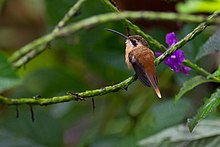Reddish hermit
| Reddish hermit | |
|---|---|

| |
| Scientific classification | |
| Domain: | Eukaryota |
| Kingdom: | Animalia |
| Phylum: | Chordata |
| Class: | Aves |
| Clade: | Strisores |
| Order: | Apodiformes |
| Family: | Trochilidae |
| Genus: | Phaethornis |
| Species: | P. ruber
|
| Binomial name | |
| Phaethornis ruber | |

| |
| Synonyms | |
|
Trochilus ruber Linnaeus, 1758 | |
The reddish hermit (Phaethornis ruber) is a species of
Taxonomy and systematics
In 1743 the English naturalist
Four subspecies are recognised:[3]
- P. r. episcopus Gould, 1857
- P. r. ruber (Linnaeus, 1758)
- P. r. nigricinctus Lawrence, 1858
- P. r. longipennis Berlepsch & Stolzmann, 1902
Some introgression has been noted between the nominate P. r. ruber and P. r. longipennis. P. r. episcopus and P. r. nigricinctus might actually be separate species but data to confirm the hypothesis are lacking. The population of P. r. ruber in southeastern Brazil has been proposed as a separate subspecies P. r. pygmaeus but its apparent differences are within the range of variation in the rest of ruber.[9]

Description
The reddish hermit is 8 to 9 cm (3.1 to 3.5 in) long and weighs 1.8 to 3 g (0.06 to 0.11 oz). All subspecies are generally dark green and rufous on the upperparts and cinnamon rufous on the underparts. Males have a black band on the chest and the tail feather have narrow white or reddish tips. Females have lighter underparts than the males. P. r. episcopus is about the same size as the nominate but has orange-rufous rather than cinnamon-rufous underparts and white tips to the tail. P. r. nigricinctus is the smallest subspecies; it has the richest rufous underparts. P. r. longipennis is the largest subspecies. It has a whitish chin and its central tail feathers have rufous tips.[9]
Distribution and habitat
The subspecies of reddish hermit are distributed thus:[3][9]
- P. r. episcopus, central and eastern Venezuela, Guyana, and northwestern Brazil's Roraima state
- P. r. ruber, Suriname and French Guiana through Brazil as far south as northern Paraná state and in the west to southeastern Peru and northern Bolivia.
- P. r. nigricinctus, eastern and southern Colombia and extreme southwestern Venezuela south through eastern Ecuador into northeastern Peru and northwestern Brazil.
- P. r. longipennis, southeastern Peru from the department of Pasco to northern Cuzco.
Behavior
Movement
The reddish hermit is assumed to be sedentary.[9]
Feeding
The reddish hermit is a "trap-line" feeder like other hermit hummingbirds, visiting a circuit of many species of flowering plants for nectar. It also consumes small arthropods. Nectar robbing by piercing the base of a flower has been regularly observed in southeastern Brazil.[9]
Breeding
The reddish hermit's breeding seasons vary throughout its large range; in general in the north it is within May to October and in the south within October to February. The nest is a cone-shaped cup made of plant fibers, mosses, lichens, other plant material, and spider web. It is attached under a drooping leaf. The clutch size is two eggs and the female alone incubates them.[9]
Vocalization
The reddish hermit's song is "a high-pitched phrase repeated incessantly with clear pauses between phrases...evenly-spaced, slightly descending, single notes followed by a number of accelerating descending notes, e.g. 'tsee....tsee...tsee...tsee.tse.tsitsi'." It frequently sings for long periods at leks. It has "long whining calls" made while hovering and a "stip!" flight call.[9]
Status
The
References
- ^ . Retrieved 28 November 2021.
- ^ "Appendices | CITES". cites.org. Retrieved 2022-01-14.
- ^ a b c d Gill, F.; Donsker, D.; Rasmussen, P. (July 2021). "IOC World Bird List (v 11.2)". Retrieved July 14, 2021.
- ^ Edwards, George (1743). A Natural History of Uncommon Birds. Vol. Part 1. London: Printed for the author at the College of Physicians. p. 32, plate 32 upper.
- ^ Linnaeus, Carl (1758). Systema Naturae per regna tria naturae, secundum classes, ordines, genera, species, cum characteribus, differentiis, synonymis, locis (in Latin). Vol. 1 (10th ed.). Holmiae (Stockholm): Laurentii Salvii. p. 121.
- ISBN 978-1-4081-2501-4.
- ^ Peters, James Lee, ed. (1945). Check-List of Birds of the World. Vol. 5. Cambridge, Massachusetts: Harvard University Press. p. 14.
- .
- ^ a b c d e f g h i Hinkelmann, C., G. M. Kirwan, and P. F. D. Boesman (2020). Reddish Hermit (Phaethornis ruber), version 1.0. In Birds of the World (J. del Hoyo, A. Elliott, J. Sargatal, D. A. Christie, and E. de Juana, Editors). Cornell Lab of Ornithology, Ithaca, NY, USA. https://doi.org/10.2173/bow.redher1.01 retrieved November 28, 2021
External links
- Stamps[usurped] (with RangeMap)
- Reddish Hermit photo gallery VIREO


